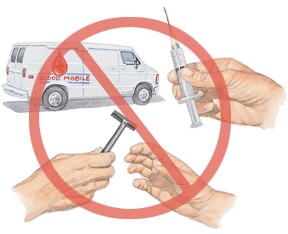
Bloodborne Pathogens Identified
Hepatitis B
Hepatitis B virus, previously known as "serum hepatitis," is contracted by exposure to contaminated blood or blood products, or through sexual contact. It is not transmitted through casual contact, and the risk of occupational exposure in the health care setting is higher than that of HIV. In other words, a health care worker has a higher chance of being exposed to HBV than HIV. The range for exposure from a needle stick is 6-30%; higher than HIV infection in similar situations. This is in part due to the concentration of the HBV in the blood.
Flu-like symptoms, including fatigue and mild fever may present; along with gastrointestinal symptoms such as vomiting, abdominal pain and diarrhea. Other symptoms can include muscle and joint aches; jaundice may also present. A severe infection can be fatal. Chronic hepatitis may result and lead to cirrhosis, liver cancer, or death in those chronic HBV carriers. HBV carriers continue to be communicable to others.
There is an effective vaccine to prevent hepatitis B infections. Any employee identified to be at risk of exposure under the Bloodborne Pathogens Standard must have the vaccine available at no cost.
If you have any questions at any time regarding the information presented in this tutorial, please contact David Sullivan at 910-916-0688.
(Eisenberg, R.L. & Johnson, N.M. (2012).Comprehensive radiographic pathology (5th Ed). St. Louis, Mo: Mosby Elsevier.)
(North Carolina Department of Labor (2010). A guide to bloodborne pathogens in the workplace.)
